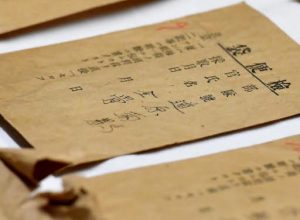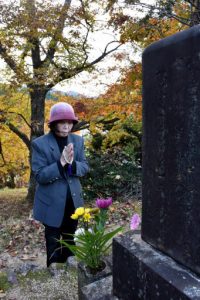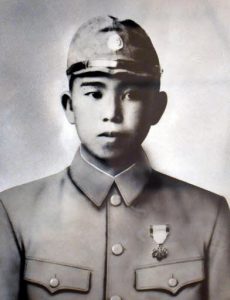Striving to fill voids in Hiroshima 75 years after the atomic bombing—RIKEN remains may be Yoshiwa victim, despite one different Chinese character
Nov. 15, 2020
by Kyosuke Mizukawa, Staff Writer
On November 14 it was learned that a family member of Kikuma Michihara, who was from the village of Yoshiwa (now part of Hatsukaichi City) and died in the atomic bombing at the age of 18, is considering asking the Hiroshima City government to investigate whether one set of the remains returned from RIKEN (with headquarters in Wako City, Saitama Prefecture) to the city on November 12 are those of her brother. Among the names provided by RIKEN with the remains was “Kikuma Michihara,” the same name as that of the person from Yoshiwa, but with one Chinese character that reads “ma” being different. According to the data recorded by a survey team at that time, the date of death, the hospital the individual was transported to, and other conditions involving Kikuma Michihara (hereinafter: Kikuma from RIKEN) match those of Kikuma Michihara from the village of Yoshiwa (Kikuma from Yoshiwa). Indicating it believes the information to be reliable, the city appears amenable to initiating an investigation.
Kiyoko Iwata, 83, a resident of Hatsukaichi City and the younger sister of Kikuma from Yoshiwa, is considering making a request of the city government to investigate the situation. “I was so surprised. If those are my brother’s remains, I would like to hold them in my arms as soon as possible. I’m sure our late parents would be pleased,” said Ms. Iwata.
The Chugoku Shimbun has looked over A-bomb testimonies and memoirs written by people whose family name was Michihara and found information on a victim from Yoshiwa whose name was Kikuma Michihara. The newspaper contacted Ms. Iwata, one of the victim’s bereaved family members, and informed her about the remains.
On August 6, 1945, Kikuma from Yoshiwa was in Hiroshima City obeying a call-up order to serve for the Chugoku Military District Infantry First Reserve (the so-called Chugoku 104 Corps), which was based on the east side of Hiroshima Castle, about 900 meters from the hypocenter. After the atomic bombing, he was transported to the Ujina branch of the Hiroshima First Army Hospital but died on August 31.
“We would often gather chestnuts and play in the snow. He was a kind brother who took good care of me.” Eight years old at the time, Ms. Iwata lived in Yoshiwa. She heard then from her late father that her brother’s body, badly wounded in the atomic bombing, had been infested with maggots.
On the other hand, according to a report of the damage from the atomic bombing of Hiroshima by a survey team dispatched by Japan’s Department of War that included researchers from RIKEN, the team started to examine patients on August 29 at the Ujina branch, where Kikuma from Yoshiwa had been admitted. Among the list of the patients whose radiation levels were measured was a person with the last name “Michihara.” An examination on that individual was carried out on September 1, the day after Kikuma from Yoshiwa had died.
A note in the report indicates that radioactivity was measured in “deceased soldiers,” which is consistent with information about Kikuma from Yoshiwa, who was an Army soldier. Although “unknown” is indicated in the list column for the location at which Kikuma from RIKEN was wounded, four out of 15 patients on the list belonged to the Chugoku 104 Corps, to which Kikuma from Yoshiwa also belonged.
Ms. Iwata once heard from her father that he had received her brother’s remains, which were then interred in a grave. Imagining his loneliness having been so far from home for 75 years, she now hopes to lay his remains to rest in their hometown of Yoshiwa, if the remains of Kikuma Michihara stored in RIKEN’s old building in Tokyo prove to be those of her brother.
Saying she could not be fully confident because of the difference in one of the Chinese characters, Ms. Iwata’s eyes filled with tears as she recounted her visit to her brother’s grave. “It felt as if he was calling out for me.”
Taking into account that Kikuma from Yoshiwa had died the day before the survey team’s examination, Itsuji Kono, a section manager at Hiroshima City’s Atomic Bomb Survivors Relief Department, explained, “The information is reliable. We had a similar case before. This kind of thing could have happened amid the chaos after the war.” The city will investigate whether or not the remains are those of Ms. Iwata’s brother by looking into documentation and conducting interviews with bereaved family members as soon as it receives a request to start such an investigation.
(Originally published on November 15, 2020)
Ms. Iwata, from Hatsukaichi, considers request to Hiroshima City for investigation into whether the remains might be her older brother’s
On November 14 it was learned that a family member of Kikuma Michihara, who was from the village of Yoshiwa (now part of Hatsukaichi City) and died in the atomic bombing at the age of 18, is considering asking the Hiroshima City government to investigate whether one set of the remains returned from RIKEN (with headquarters in Wako City, Saitama Prefecture) to the city on November 12 are those of her brother. Among the names provided by RIKEN with the remains was “Kikuma Michihara,” the same name as that of the person from Yoshiwa, but with one Chinese character that reads “ma” being different. According to the data recorded by a survey team at that time, the date of death, the hospital the individual was transported to, and other conditions involving Kikuma Michihara (hereinafter: Kikuma from RIKEN) match those of Kikuma Michihara from the village of Yoshiwa (Kikuma from Yoshiwa). Indicating it believes the information to be reliable, the city appears amenable to initiating an investigation.
Kiyoko Iwata, 83, a resident of Hatsukaichi City and the younger sister of Kikuma from Yoshiwa, is considering making a request of the city government to investigate the situation. “I was so surprised. If those are my brother’s remains, I would like to hold them in my arms as soon as possible. I’m sure our late parents would be pleased,” said Ms. Iwata.
The Chugoku Shimbun has looked over A-bomb testimonies and memoirs written by people whose family name was Michihara and found information on a victim from Yoshiwa whose name was Kikuma Michihara. The newspaper contacted Ms. Iwata, one of the victim’s bereaved family members, and informed her about the remains.
On August 6, 1945, Kikuma from Yoshiwa was in Hiroshima City obeying a call-up order to serve for the Chugoku Military District Infantry First Reserve (the so-called Chugoku 104 Corps), which was based on the east side of Hiroshima Castle, about 900 meters from the hypocenter. After the atomic bombing, he was transported to the Ujina branch of the Hiroshima First Army Hospital but died on August 31.
“We would often gather chestnuts and play in the snow. He was a kind brother who took good care of me.” Eight years old at the time, Ms. Iwata lived in Yoshiwa. She heard then from her late father that her brother’s body, badly wounded in the atomic bombing, had been infested with maggots.
On the other hand, according to a report of the damage from the atomic bombing of Hiroshima by a survey team dispatched by Japan’s Department of War that included researchers from RIKEN, the team started to examine patients on August 29 at the Ujina branch, where Kikuma from Yoshiwa had been admitted. Among the list of the patients whose radiation levels were measured was a person with the last name “Michihara.” An examination on that individual was carried out on September 1, the day after Kikuma from Yoshiwa had died.
A note in the report indicates that radioactivity was measured in “deceased soldiers,” which is consistent with information about Kikuma from Yoshiwa, who was an Army soldier. Although “unknown” is indicated in the list column for the location at which Kikuma from RIKEN was wounded, four out of 15 patients on the list belonged to the Chugoku 104 Corps, to which Kikuma from Yoshiwa also belonged.
Ms. Iwata once heard from her father that he had received her brother’s remains, which were then interred in a grave. Imagining his loneliness having been so far from home for 75 years, she now hopes to lay his remains to rest in their hometown of Yoshiwa, if the remains of Kikuma Michihara stored in RIKEN’s old building in Tokyo prove to be those of her brother.
Saying she could not be fully confident because of the difference in one of the Chinese characters, Ms. Iwata’s eyes filled with tears as she recounted her visit to her brother’s grave. “It felt as if he was calling out for me.”
Taking into account that Kikuma from Yoshiwa had died the day before the survey team’s examination, Itsuji Kono, a section manager at Hiroshima City’s Atomic Bomb Survivors Relief Department, explained, “The information is reliable. We had a similar case before. This kind of thing could have happened amid the chaos after the war.” The city will investigate whether or not the remains are those of Ms. Iwata’s brother by looking into documentation and conducting interviews with bereaved family members as soon as it receives a request to start such an investigation.
(Originally published on November 15, 2020)










